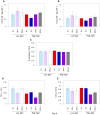Spectral radiation dependent photoprotective mechanism in the diatom Pseudo-nitzschia multistriata
- PMID: 24475212
- PMCID: PMC3901731
- DOI: 10.1371/journal.pone.0087015
Spectral radiation dependent photoprotective mechanism in the diatom Pseudo-nitzschia multistriata
Abstract
Phytoplankton, such as diatoms, experience great variations of photon flux density (PFD) and light spectrum along the marine water column. Diatoms have developed some rapidly-regulated photoprotective mechanisms, such as the xanthophyll cycle activation (XC) and the non-photochemical chlorophyll fluorescence quenching (NPQ), to protect themselves from photooxidative damages caused by excess PFD. In this study, we investigate the role of blue fluence rate in combination with red radiation in shaping photoacclimative and protective responses in the coastal diatom Pseudo-nitzschia multistriata. This diatom was acclimated to four spectral light conditions (blue, red, blue-red, blue-red-green), each of them provided with low and high PFD. Our results reveal that the increase in the XC pool size and the amplitude of NPQ is determined by the blue fluence rate experienced by cells, while cells require sensing red radiation to allow the development of these processes. Variations in the light spectrum and in the blue versus red radiation modulate either the photoprotective capacity, such as the activation of the diadinoxanthin-diatoxanthin xanthophyll cycle, the diadinoxanthin de-epoxidation rate and the capacity of non-photochemical quenching, or the pigment composition of this diatom. We propose that spectral composition of light has a key role on the ability of diatoms to finely balance light harvesting and photoprotective capacity.
Conflict of interest statement
Figures






Similar articles
-
The velocity of light intensity increase modulates the photoprotective response in coastal diatoms.PLoS One. 2014 Aug 1;9(8):e103782. doi: 10.1371/journal.pone.0103782. eCollection 2014. PLoS One. 2014. PMID: 25083713 Free PMC article.
-
Influence of the diadinoxanthin pool size on photoprotection in the marine planktonic diatom Phaeodactylum tricornutum.Plant Physiol. 2002 Jul;129(3):1398-406. doi: 10.1104/pp.002014. Plant Physiol. 2002. PMID: 12114593 Free PMC article.
-
Growth form defines physiological photoprotective capacity in intertidal benthic diatoms.ISME J. 2015 Jan;9(1):32-45. doi: 10.1038/ismej.2014.105. Epub 2014 Jul 8. ISME J. 2015. PMID: 25003964 Free PMC article.
-
Diversity in Xanthophyll Cycle Pigments Content and Related Nonphotochemical Quenching (NPQ) Among Microalgae: Implications for Growth Strategy and Ecology.J Phycol. 2020 Apr;56(2):245-263. doi: 10.1111/jpy.12944. Epub 2020 Feb 5. J Phycol. 2020. PMID: 31674660 Review.
-
Carotenoid biosynthesis in diatoms.Photosynth Res. 2010 Nov;106(1-2):89-102. doi: 10.1007/s11120-010-9589-x. Epub 2010 Aug 24. Photosynth Res. 2010. PMID: 20734232 Review.
Cited by
-
From Sea to Skin: Is There a Future for Natural Photoprotectants?Mar Drugs. 2021 Jun 30;19(7):379. doi: 10.3390/md19070379. Mar Drugs. 2021. PMID: 34209059 Free PMC article. Review.
-
Microalgal Derivatives as Potential Nutraceutical and Food Supplements for Human Health: A Focus on Cancer Prevention and Interception.Nutrients. 2019 May 29;11(6):1226. doi: 10.3390/nu11061226. Nutrients. 2019. PMID: 31146462 Free PMC article. Review.
-
Underwater light climate and wavelength dependence of microalgae photosynthetic parameters in a temperate sea.PeerJ. 2021 Oct 4;9:e12101. doi: 10.7717/peerj.12101. eCollection 2021. PeerJ. 2021. PMID: 34707925 Free PMC article.
-
Antioxidant and Photoprotection Networking in the Coastal Diatom Skeletonema marinoi.Antioxidants (Basel). 2019 Jun 1;8(6):154. doi: 10.3390/antiox8060154. Antioxidants (Basel). 2019. PMID: 31159429 Free PMC article.
-
Trade-off between sex and growth in diatoms: Molecular mechanisms and demographic implications.Sci Adv. 2022 Jan 21;8(3):eabj9466. doi: 10.1126/sciadv.abj9466. Epub 2022 Jan 19. Sci Adv. 2022. PMID: 35044817 Free PMC article.
References
-
- Falkowski GP, Raven JA (2007) Aquatic photosynthesis. 2nd edition, Princeton University Press, USA.
-
- Rasmussen B, Fletcher IR, Brocks JJ, Kilburn MR (2008) Reassessing the first appearance of eukaryotes and cyanobacteria. Nature 455: 1101–1104. - PubMed
-
- MacIntyre HL, Kana TM, Geider RJ (2000) The effect of water motion on short-term rates of photosynthesis by marine phytoplankton. Trends Plant Sci 5: 12–17. - PubMed
-
- Litchman E, Klausmeier CA (2001) Competition of phytoplankton under fluctuating light. Am Nat 157: 170–187. - PubMed
-
- Kirk JTO (1994) Light and Photosynthesis in Aquatic Ecosystems: Cambridge–London–New York: Cambridge University Press. 401 p.
Publication types
MeSH terms
Substances
LinkOut - more resources
Full Text Sources
Other Literature Sources

